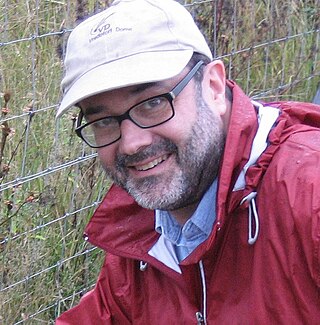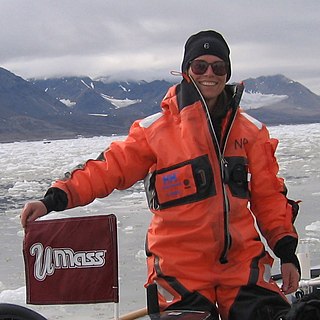Related Research Articles

A meteorite is a solid piece of debris from an object, such as a comet, asteroid, or meteoroid, that originates in outer space and survives its passage through the atmosphere to reach the surface of a planet or moon. When the original object enters the atmosphere, various factors such as friction, pressure, and chemical interactions with the atmospheric gases cause it to heat up and radiate energy. It then becomes a meteor and forms a fireball, also known as a shooting star; astronomers call the brightest examples "bolides". Once it settles on the larger body's surface, the meteor becomes a meteorite. Meteorites vary greatly in size. For geologists, a bolide is a meteorite large enough to create an impact crater.

Meteor Crater, or Barringer Crater, is a meteorite impact crater about 37 mi (60 km) east of Flagstaff and 18 mi (29 km) west of Winslow in the desert of northern Arizona, United States. The site had several earlier names, and fragments of the meteorite are officially called the Canyon Diablo Meteorite, after the adjacent Cañon Diablo. Because the United States Board on Geographic Names recognizes names of natural features derived from the nearest post office, the feature acquired the name of "Meteor Crater" from the nearby post office named Meteor.

An impact event is a collision between astronomical objects causing measurable effects. Impact events have physical consequences and have been found to regularly occur in planetary systems, though the most frequent involve asteroids, comets or meteoroids and have minimal effect. When large objects impact terrestrial planets such as the Earth, there can be significant physical and biospheric consequences, though atmospheres mitigate many surface impacts through atmospheric entry. Impact craters and structures are dominant landforms on many of the Solar System's solid objects and present the strongest empirical evidence for their frequency and scale.

A Martian meteorite is a rock that formed on Mars, was ejected from the planet by an impact event, and traversed interplanetary space before landing on Earth as a meteorite. As of September 2020, 277 meteorites had been classified as Martian, less than half a percent of the 72,000 meteorites that have been classified. The largest complete, uncut Martian meteorite, Taoudenni 002, was recovered in Mali in early 2021. It weighs 14.5 kilograms and is on display at the Maine Mineral & Gem Museum.

An ejecta blanket is a generally symmetrical apron of ejecta that surrounds an impact crater; it is layered thickly at the crater's rim and thin to discontinuous at the blanket's outer edge. The impact cratering is one of the basic surface formation mechanisms of the solar system bodies and the formation and emplacement of ejecta blankets are the fundamental characteristics associated with impact cratering event. The ejecta materials are considered as the transported materials beyond the transient cavity formed during impact cratering regardless of the state of the target materials.
Susan Elizabeth Werner Kieffer is an American physical geologist and planetary scientist. Kieffer is known for her work on the fluid dynamics of volcanoes, geysers, and rivers, and for her model of the thermodynamic properties of complex minerals. She has also contributed to the scientific understanding of meteorite impacts.
Gerald J. Wasserburg was an American geologist. At the time of his death, he was the John D. MacArthur Professor of Geology and Geophysics, Emeritus, at the California Institute of Technology. He was known for his work in the fields of isotope geochemistry, cosmochemistry, meteoritics, and astrophysics.

Idun Reiten is a Norwegian professor of mathematics. She is considered to be one of Norway's greatest mathematicians today.
The Ritland crater is an impact crater at Ritland farm in Hjelmeland municipality in eastern Rogaland county, Norway. The crater is about 15 kilometres (9.3 mi) east of the village of Hjelmelandsvågen and about 8 kilometres (5.0 mi) south of the Jøsenfjorden. The crater is about 2 kilometres (1.2 mi) in diameter, and was created when a meteorite with an estimated diameter of 100 metres (330 ft) struck here about 500–600 million years ago. The crater was later buried by sediments, of which it has been partly recovered.
Peter H. Schultz is Professor of Geological Sciences at Brown University specializing in the study of planetary geology, impact cratering on the Earth and other objects in the Solar System, and volcanic modifications of planetary surfaces. He was co-investigator to the NASA Science Mission Directorate spacecraft Deep Impact and the Lunar Crater Observation and Sensing Satellite (LCROSS). He was awarded the Barringer Medal of the Meteoritical Society in 2004 for his theoretical and experimental studies of impact craters.

Mojave is a 58 km diameter impact crater in the Oxia Palus quadrangle of Mars, located at 7.5° N and 33.0° W. It was named after the town of Mojave in southern California, U.S.
Mars may contain ores that would be very useful to potential colonists. The abundance of volcanic features together with widespread cratering are strong evidence for a variety of ores. While nothing may be found on Mars that would justify the high cost of transport to Earth, the more ores that future colonists can obtain from Mars, the easier it would be to build colonies there.

Christian Köberl is a professor of impact research and planetary geology at the University of Vienna, Austria. From June 2010 to May 2020 he was director general of the Natural History Museum in Vienna. He is best known for his research on meteorite impact craters.

Ronald Greeley was a Regents’ Professor in the School of Earth and Space Exploration (SESE) at Arizona State University (ASU), the Director of the NASA-ASU Regional Planetary Image Facility (RPIF), and Principal Investigator of the Planetary Aeolian Laboratory at NASA-Ames Research Center. He was involved with lunar and planetary studies since 1967 and most recently focused his research on understanding planetary surface processes and geologic histories.
The Tunnunik impact crater, formerly known as the Prince Albert Impact Crater, is a recently confirmed meteorite impact crater. It is located on Prince Albert Peninsula in the northwestern part of Victoria Island in Canada's Northwest Territories.

Ursula Bailey Marvin was an American planetary geologist and author who worked for the Smithsonian Astrophysical Observatory.

The Amazonian is a geologic system and time period on the planet Mars characterized by low rates of meteorite and asteroid impacts and by cold, hyperarid conditions broadly similar to those on Mars today. The transition from the preceding Hesperian period is somewhat poorly defined. The Amazonian is thought to have begun around 3 billion years ago, although error bars on this date are extremely large. The period is sometimes subdivided into the Early, Middle, and Late Amazonian. The Amazonian continues to the present day.

Bethany List Ehlmann is a Professor of Planetary Science at California Institute of Technology and a Research Scientist at the Jet Propulsion Laboratory.

Julie Brigham-Grette is a glacial geologist and a professor in the Department of Geosciences at the University of Massachusetts Amherst where she co-directs the Joseph Hartshorn Quaternary Laboratory. Her research expertise is in glacial geology and paleoclimatology; she has made important contributions to Arctic marine and terrestrial paleoclimate records of late Cenozoic to recent, the evolution of the Arctic climate, especially in the Beringia/Bering Strait region, and was a leader of the international Lake El’gygytgyn Drilling Project in northeastern Russia.
Penelope King uses geochemistry and cosmochemistry to study planetary processes to better understand past and future planetary environments, and what this information may tells us about climate change. She is a professor at the Australian National University (ANU) in the Research School of Earth Sciences (RSES). King holds many awards, including Fellow of the American Geophysical Union and the Mineralogical Society of America in 2019, and winning the AGU Joanne Simpson Medal for Mid-Career Scientists the same year. She currently leads a research group examining surface and interior processes on planetary bodies.
References
- ↑ Birth year from German National Library catalog entry, retrieved 2020-03-20
- ↑ Bennington-Castro, Joseph (6 March 2014), "Meteorites on Earth May Be From Ancient Crater on Mars, Study Says", National Geographic
- ↑ Strain, Daniel (12 August 2019), "A new timeline of Earth's cataclysmic past", CU Boulder Today, University of Colorado Boulder
- 1 2 Stephanie Werner, University of Oslo Department of Geosciences, retrieved 2020-03-20
- ↑ Academy Members, Norwegian Academy of Science and Letters , retrieved 2020-03-20
- ↑ "11449 Stephwerner (1979 QP)", JPL Small-Body Database, Jet Propulsion Laboratory, retrieved 2020-03-20